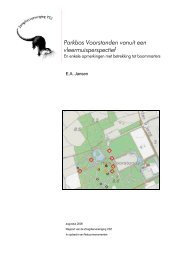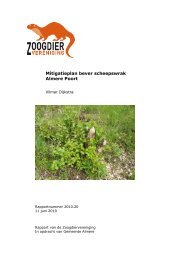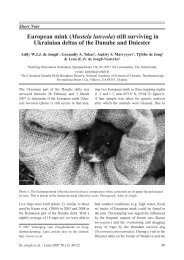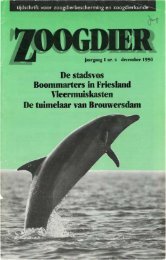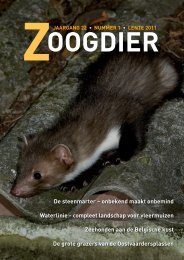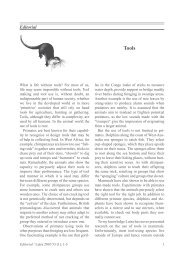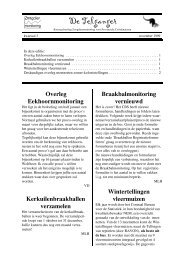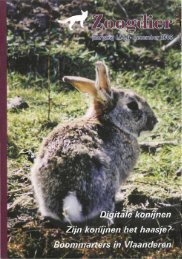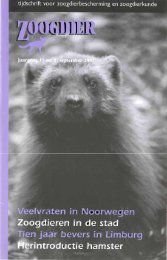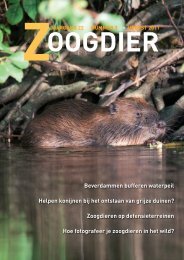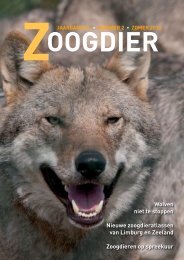binnenwerk 48-2-2005 - De Zoogdiervereniging
binnenwerk 48-2-2005 - De Zoogdiervereniging
binnenwerk 48-2-2005 - De Zoogdiervereniging
Create successful ePaper yourself
Turn your PDF publications into a flip-book with our unique Google optimized e-Paper software.
Possible occurrence in the 1950s and 1960sThere are a number of striking records of cats inthe wild in the Netherlands that date from the1950s and 1960s. Van Bree (1959, 1963), laterthe curator of mammals at the Zoological Museumof Amsterdam, and several other authors,have discussed these records in publications(Anonymous 1959, 1961, 1962, 1965, de Haan1970). At this time it was legal to kill feral domesticcats throughout the year. Some cats shotin this period are reported to have had characteristicssimilar to those of a wildcat, for exampletheir coat colour, pattern and a bushy ringed tail.Incited by the first uncertain observations andthe publications in this period the public waspossibly more eager to find ‘wildcats’. However,in all those cases where the animal could bechecked for internal characteristics (see above),it appeared that at least one crucial feature didnot allow identification as a true wildcat.Thus, no single record of the wildcat in the1950s and 1960s can be proven to be completelyconclusive. Van Bree et al. (1971) eventuallyconcluded that there was no indisputable evidenceto support the occurrence of the wildcat inthe Netherlands at this time. Consequently thepresence of this carnivore in the Netherlands remainedunsupported. Yet, one young tomcatcaught close to Ter Worm Castle, west ofHeerlen, in 1963 (presently in the collection ofthe Natuurhistorisch Museum Maastricht, Maastricht:NHM St.951 z) was claimed to be a wildcat(e.g. Moonen 1975, Vergoossen & van derCoelen 1986). However, as Van Bree et al.(1971) argued its measurements did not excludeit being a domestic cat (see also: Moonen 1975).In the text of the first mammal atlas of theNetherlands Van Wijngaarden et al. (1971) mentiononly the dubious record from Heerlen (vanBree 1963), although the reference list also citesa publication about an alleged wildcat at Haelen(van Bree 1959).It is thought that at this time there might havebeen a small, but stable, population in theRothaar hill range (Sauerland) in Westphalia,Germany (Feldmann 1984).Possible occurrence in the 1970s, 1980s andearly 1990sWe could find no records of wildcats in theNetherlands in the 1970s and 1980s. The secondmammal distribution atlas of the Netherlands(Broekhuizen et al. 1992), which covers the period1970-1988, does not mention the wildcat atall. Yet, Lange et al. (1994) stated that the wildcat,if not already present in the Netherlands, was approachingthe borders of our country. Evidencefor this statement stems from the finding of footprintsby one of the authors (A. van Diepenbeek)on 6 May 1991, which were attributed to wildcat.This was at Eyneburg Castle near Hergenrath inBelgium, just over six kilometres from the Dutchborder, south of Vaals. Broekhuizen (1996) takesmore or less the same line, speaking about “thesteady expansion of the distribution area of thewildcat in the direction of southern Limburg, theNetherlands”. Parent (1986) however, in his publicationon the current occurrence and legal statusof carnivores in Belgium and the Netherlands, onlymentions the wildcat in passing, in the contextof it only being indirectly protected by the DutchHunting Act.In the forest of Reichswald in Germany, justacross the border near Nijmegen, Gerard Müskensand one of the authors (J. Thissen) found a roadcasualty cat (NL RD-coordinates: 203/417) on 19April 1987. Van Bree (personal communication),who examined the badly damaged remains(ZMA 23.331), identified this animal as a hybridbetween a wildcat and a domestic cat.In the course of the 1990s there were rumouredsightings of wildcats on several occasionsin southern Limburg, the Netherlands. Wemanaged to trace these rumours to observationsmade in the surroundings of Vaals, the mostsoutheastern part of Limburg, by Leo Backbier.As Backbier died in 2004, we have not beenable to make further inquiries. His zoologicalarchives are not currently accessible (E.Gubbels, personal communication) and, as far aswe could find out, nothing has been published onthese observations. There are no photographs ofany wildcat traces. Since there is no physical orCanters et al. / Lutra <strong>2005</strong> <strong>48</strong> (2): 67-90 73



